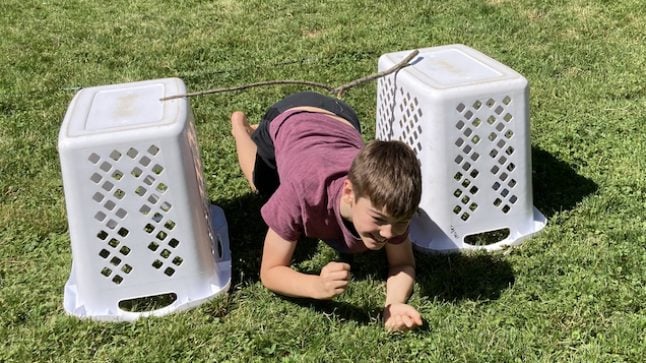Series: Ideas at Work
Taking Math Out for a Spin: Outside Activities for Kids That Have Math

Warm weather and more daylight hours mean now is a great time to take advantage of outdoor spaces. There are so many ways to incorporate math into your child’s outside activity. Obstacle Courses and the Bean Bag Toss are two fun outside activities for kids that are already rich with math: spatial awareness, geometry, measurement, number sense, and counting… you can even find ways to develop data analysis!
Obstacle Courses
There is a lot of math to be found in obstacle courses, from planning the course and the actions to describing the movement as you go. With older children, you can incorporate measurement and data analysis.
Highlighting the math in Obstacle Courses:
- Use household items, such as sheets, brooms, pots, tables, and chairs and/or outdoor items such sticks, rocks, and trees to create the course. Together you can design the shape of the course: will it be circular, straight or something else?
- Call out what to do when they get to each obstacle using directions that develop spatial relationships; “walk over the broom,” “walk around the tree,” “step on the stick,” “crawl under the sheet,” etc.
- After designing and creating the course outdoors, older children can use a stopwatch to time how long it takes to complete the course. Record each time they do the course and compare the results to see if they are getting faster and use the data to analyze why or why not.
- Children can also draw a map of the course, either before as part of the planning process, or after as a way to share their fun with others. Be sure to have them include arrows that show the movements and actions.
- You can also involve measurement with obstacle courses by comparing the length and heights of the different obstacles. To keep your obstacle course exciting, after you measure the obstacles, you can decide if you want to change them and measure how much taller, shorter, longer, or wider you want to make them.


The best part using an obstacle course is that you can change it whenever you want. Children stay interested and use it over and over again.
Bean Bag Toss
Cornhole or Bags are popular games at many summer gatherings. These are family-friendly outside activities for kids that any age can play. While playing, they develop counting skills, spatial reasoning, and measurement. You don’t even need a board with a hole in it to play. You can easily create your target with household items and play in the grass , or draw your target with chalk on the sidewalk.
Highlighting the math in Bean Bag Toss games:
- With younger or less experienced children, use a hula hoop or draw a circle with chalk on the sidewalk. Use five bags to toss towards the target. No bags? You can even use sponges or balls of socks! After the child tosses the bags, talk about how many bags are in the circle and how many are outside the circle; are the bags near the target, or are they are far away from the target? Talk about how there are still five bags, even though there are some bags inside and some bags outside the circle.
- Older or more experienced children can draw a multi-leveled target with different point values on the sidewalk and record their points.
- Play Bean Bag Toss as a carnival game by drawing a row of circles on the sidewalk or placing buckets, pots, or other types of containers in a row. As you create the row of chalk circles or buckets, you can measure to make sure there is equal distance between each one. Additionally, you can measure the length of the entire row. Start with just three spots and add on to make the row longer.
- If you are playing with chalk on the sidewalk, you can create a “scoreboard” for your child(ren) to fill in.

